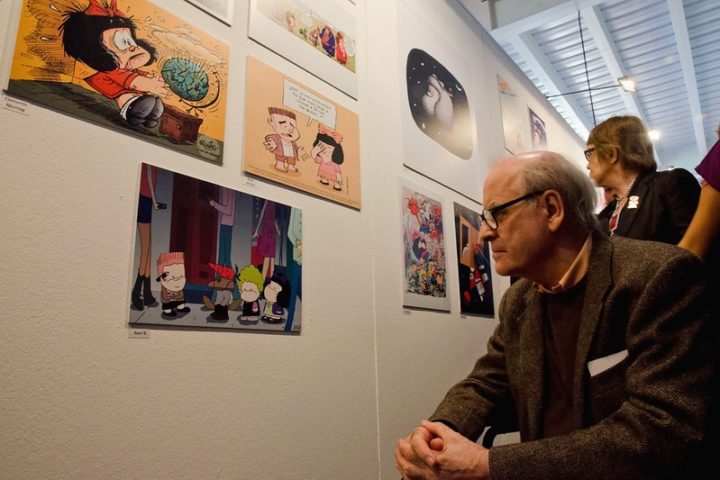Mafalda is an iconic Spanish-language comic strip character
On September 30, 88-year-old award winning Argentine cartoonist Joaquín Salvador Lavado Tejón passed away. He is better known as Quino, the creator of the famous comic strip character Mafalda—the revolutionary, feminist, environmentalist and humanist girl who conquered the hearts of several generations.
Quino’s death occurs one day after the 56th anniversary of Mafalda’s first publication. The news immediately reached all corners of the world and inspired heartfelt tributes from countless media outlets, artists and public figures.
The Mafalda strip became one of the best known Spanish-language cartoons and was translated into more than 30 languages, including the native language Guaraní. Its messages on politics, society, the environment and feminism are universal, and still relevant in present times.
Like much of Quino’s work, Mafalda was highly controversial for its time. With her subtle humor, she managed to outwit the censorship of the Argentine dictatorship, although she was banned by the dictator Augusto Pinochet in Chile.
In addition to print media (cartoons, magazines and books), Mafalda and her friends starred in their own television series. In just nine years (between 1964 and 1973), she conquered the entire world and became a “universal symbol of rebellion and faith in a better world”.
Following the news of Quino’s death, social media was flooded with his comics and tributes from other graphic artists from Argentina and the world.
This message is from Liniers, an Argentine cartoonist currently living in the United States:
??? pic.twitter.com/9wImYi6vPR
— Liniers (@porliniers) September 30, 2020
Luly, another illustrator from Buenos Aires, also expresses her gratitude and condolences:
Children’s cartoon illustrator Nik emphasizes that Mafalda is now an “orphan”:
Se fue el más grande de todos. ? pic.twitter.com/T26JhtlLW4
— Nik (@Nikgaturro) September 30, 2020
The artist Horacio Altuna from Cordoba also expressed his grief:
— Horacio Altuna (@HoracioAltuna) September 30, 2020
The well-known graphic humorist Tute (the son of famous cartoonist Caloi) says his farewell to Quino with a drawing for him:
Hoy se nos fue Quino, a quien tanto quería. Maestro de maestros, inolvidable. Gracias por tanto, Quinito ♥️
(Ahora estoy haciendo un dibujo para despedirlo). pic.twitter.com/4B351C4thE— Tute (@Tutehumor) September 30, 2020
Today, Quino, whom I loved so much, left us. A master of masters, unforgettable. Thank you so much, Quinito ♥ ️
(I’m making a drawing to say farewell to him).
Artists from around the world also paid their respects to Quino. The Greek cartoonist Panos Zacharis created this illustration:
Colombian artist Nani, who had the opportunity to meet Quino personally, expresses his farewells with regret:
Tuve el honor de conocer a Quino, era un ser excepcional, sencillo, cercano, cariñoso. Por eso la grandeza de su trabajo, Magola está inspirada en Mafalda, siempre fue mi maestro, reconozco que no le llego ni a los tobillos, ahora las dos, las tres lloramos su ausencia pic.twitter.com/81JjIY6RJP
— tira cómica Magola (@naniopina) September 30, 2020
I had the honor of meeting Quino, he was an exceptional, straightforward, approachable and affectionate human being. That is why his great work (Magola is inspired by Mafalda) was always my teacher, but I admit that I am not at his level; now, the two of us, the three of us, mourn his absence.
From Brazil, Carlos Ruas said:
Quino vai fazer falta para o mundo. Agora, ele está no panteão dos deuses dos quadrinhos, e seu legado é simplesmente inegualável. Se eu sou crítico em meu trabalho hoje, é porque ele me ensinou isso em seus livros. pic.twitter.com/RtBffCquvf
— Carlos Ruas (@sabadoqualquer) September 30, 2020
The world will miss Quino. Now he’s in the pantheon of the comic strip gods, and his legacy is simply unmatched. If I am so critical of my work today, it is because I learned from him.
The Chilean cartoonist Nagú showed his appreciation for Quino’s legacy:
Gracias por tanto Quino. pic.twitter.com/4pI79VJCDg
— Nagú (@nagu_cl) September 30, 2020
Thank you so much, Quino.
Frenchman Fred Sochard praises the rebellion of the little girl Mafalda, while also referring to a recent debate about the dress of high school students:
En guise d'hommage à Quino… avec Mafalda, une jeune fille qui n'a pas sa langue dans sa poche ! pic.twitter.com/rNYHQowuCh
— Fred Sochard (@FredSochard) September 30, 2020
Honoring Quino … with a drawing of Mafalda, a young woman who does not remain silent.
In the image: “We, girls, dress how we want.”
Venezuelan cartoonist EDO Ilustrado shares the impact Mafalda had on generations of children:
Chau Quino. Mafalda y todos los niños vivimos en un mundo mejor, gracias a ti. #Quino #joaquinsalvadorlavado #mafalda pic.twitter.com/1dHG84D3VQ
— EDO (@edoilustrado) September 30, 2020
Good bye, Quino. Mafalda and all the children live in a better world thanks to you.
And Honduran illustrator Allan McDonald conveys his pain in the image of Mafalda:
— mcaricatura@gmail.com (@ALLANMCDONALD) September 30, 2020
Do not go! I promise to eat the soup.
This is the tribute by Italian cartoonist Mauro Biani:
Per #Quino pic.twitter.com/zLIpwc5aku
— Mauro Biani (@maurobiani) September 30, 2020
There is no doubt that Quino’s legacy and his teachings will live on forever in people’s hearts, and his work will continue to delight generations to come.
Written by Romina Navarro










